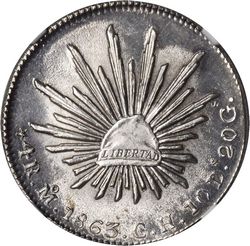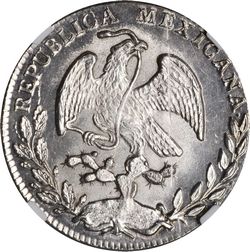Republican 4 Reales
by Dave Busse


KM-375.6. 4r Mexico City 1863/2 Mo CH (Stack’s Bowers ANA auction, 16 August 2019, lot 21346)
If you have chosen to collect the Republic Cuatro Reales (4R), I simultaneously offer admiration for your fortitude while extending sincere sympathy as the 4R series is one of the most rewarding, but it is more than difficult to assemble. It is especially challenging if you are attempting to complete the series by Date (any grade) or Mint/Type/Style in high-grade (EF or better). It is a series requiring some discretionary funds and an even greater amount of time in order to attain anything other than the most modest of goals. The disappointments are frequent and vexing but the rewards are more than satisfying. The standard Republic 4R is 32mm in diameter and of the same silver fineness (90.27% silver and 9.73% copper) as the 8R and the other silver minors (diameters can vary from year to year and mint to mint. This is especially noticeable in San Luis Potosí and Zacatecas. Research has convinced me those variances were probably because the mints frequently struck the coins without a collar. Personally, I try to measure 4R by both the horizontal and vertical axis. Very few – particularly those minted prior to 1860 – have the same horizontal and vertical diameters). The 4R’s standard weight is 13.536 grams. Usually the edge design is referred to as ornamental, but there are two exceptions, with the Oaxaca mint. The 4R has the same basic design as the 8R and the other Cap and Rays Minors. The Eagle side feature the ancient Aztec symbol of victory – an eagle grasping a water snake in its beak and its right claw while using the other leg to stand on a cactus that is rising out of Lake Texcoco. Below and to the right are laurel branches, leaves and berries, to the left are oak branches with leaves and acorns. The legend around the top half of the outer perimeter of the coin reads REPUBLICA MEXICANA. Sometimes there is a dot after MEXICANA and sometimes there is not. The reverse features a Phrygian Cap with the word LIBERTAD (Liberty) in block letters across its base. Extending out from behind the Cap are Rays. Thus, the design signifies the dawning of liberty (freedom from Spanish rule) in Mexico. The reverse legend reads “★ 4R • MM • date • assayer initials • fineness • ” for example a Zacatecas 4R minted in 1831 would read: ★ 4R • ZS • 1831 • O • M • 10 DS • 20 GS • . Note that there were several variances from mint to mint and even year to year within an individual mint such as a six, seven or even eight pointed star instead of the normal five pointed one, irregular spacing in the legends, missing or improperly placed dots, missing superscript “S” and reversed superscript “S“. In addition, there were over-dates, over-assayers, and re-punched stars, dots, mintmarks, dates, assayer initials, fineness numbers and letters that many collectors of the series find fascinating. Depending on how much detail one chooses to include in one’s collecting criteria, varieties can be almost endless as nearly every set of dies was at least slightly different from those preceding and following. An interesting one is the number of berries and acorns in the wreath below the Eagle. I have seen as many as six and as few as two. Some collectors use the term “Incomplete Wreath” to describe such a variety. Note that the Facing Eagle 2R, 1R and ½R had the same basic design except for the appropriate denomination and the fact each smaller denomination had half the silver of the previous.
Like the 50¢ in both Mexico and its northern neighbor the 4R was not that popular with the mints as evidenced by the relatively few that were actually struck. However, most of the 4R did circulate heavily (It is possible that the miners were paid with 4R). It seems that none of the ten mints that produced 4R ever struck a large number of them in any single year. Even the Mexico City mint was not exempt. It struck the first 4R – by any mint – in 1827, but did not produce another until 1850. In fact, Mexico City only issued the 4R in twelve of the forty-two years (1824-1868, leaving out 1864-66 because of the Maximilian episode) it produced minor Real coinage. As one might expect, aside from a few “common” Date/Assayer/Mintmark examples from Guanajuato and Zacatecas, finding a true Uncirculated 4R is a difficult endeavor. Another problem the collector faces is that this issue often comes with softly struck centers even in the better condition coins so grading them properly can be difficult. Being eternally optimistic, one continues to hope that there are some high-grade examples out there just waiting to be discovered, perhaps a hoard of 4R! I know one serious collector who acquires only BU 4R. It is doubtful that collector will ever have a large number of these coins and even less likely that the collection will contain a mint state example from each of the mints that struck the 4R. Another collector friend once told me that he believed any collection containing ten mint state Republic 4R is a World Class Collection. I agree with him completely. For an excellent picture of an exceptional Mexico City 4R, refer to Hubbard-Buttrey 6, page 76. In my view, they do not come any better.
There is no record of a Hookneck Eagle 4R being struck at any mint. In fact, no mint struck any 4R until 1827 when Mexico City issued the first of the series. Interestingly all known 1827 4R are the over-date – 1827, 7/6 – therefore it is just possible that there is an 1826 out there. However, a more likely explanation is that the dies were prepared in 1826 but for reasons unknown to us production did not start until 1827, thus the last digit was over-punched. Another interesting fact about the ’27 4R is that it comes with both medal and coin orientations. The next 4R issue came three years later from Zacatecas, which was the only mint to strike 4R from 1830 through 1834. Starting in 1835 at least two mints, and in some years up to six, struck the 4R. There was a two-year hiatus in 1865 and 1866 because of the Maximilian episode. Production of the 4R restarted in 1867 but halted permanently sometime during 1870. The following mints produced the Facing Eagle 4R:
| Mint | Year(s) Issued |
| Catorce | 1863 |
| Culiacán | 1846, 1850, 1852, 1857, 1858, 1860 |
| Guadalupe y Calvo | 1844-47, 1849-50 |
| Guadalajara | 1843-50, 1852, 1854-60, 1863 |
| Guanajuato | 1835-63, 1867-69, 1870 |
| Hermosillo | 1861-62 & 1867 |
| Mexico City | 1827, 1850, 1852, 1854-56, 1859, 1861-63, 1867-68 |
| Oaxaca | 1861 |
| San Luis Potosí | 1837-38, 1842-64, 1868-69 |
| Zacatecas | 1830-64, 1868-70 |
At this time, as far as we know, Alamos, Chihuahua, Durango and Estado de Mexico did not strike the 4R.
